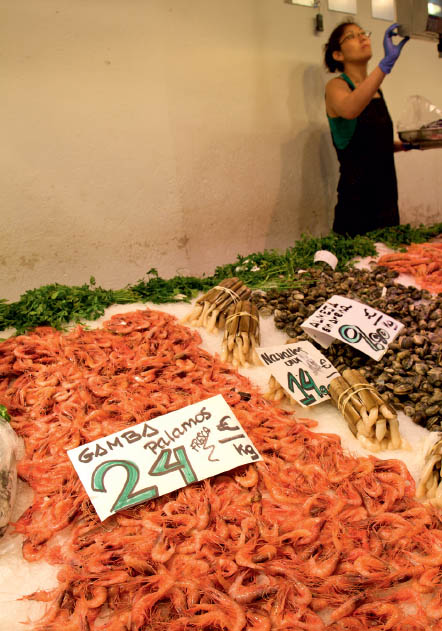SERVES 6
Baroque, regal, and always impressive carried out to the table, shellfish paella is one of Spanish cuisine’s grandest dishes. For me, it also best represents this culture where food and family often swing hand and hand. My mother-in-law, Rosa, has been making one of these paellas nearly every weekend for fifty years. It was around her shellfish paella that I met the family of the woman I had followed to Barcelona in 1996, and where countless other memorable occasions have been announced and celebrated since. Over plates of her golden, flavorful rice, I learned how a simple staple could be converted into a family bond. I was so enamored with this concept that I wrote my first cookbook about Spanish rice dishes, with Rosa’s paella at its center. And while this isn’t exactly her recipe here—you can find it in that first book, La Paella—her influence is clearly discernible.
If there is anything that I have learned from Rosa about her paella, it is that it is a rice dish—not a seafood dish with rice. As I repeat elsewhere in the book, everything is done to flavor the rice. Using a good Spanish short- or medium-grain variety or one of the options listed in the Note following is crucial. As well, note that the clams are best prepared separately, because if they have any sand at all, they will wreck the rice. Before preparing, see my full list of hints, suggestions, and techniques on page 136.
1. Purge the clams of any sand by soaking them in salty water following the directions on page 341. Discard any with broken shells.
2. In a saucepan, add the clams, cover with 1 cup/ 240 ml water, and bring to a boil. Cover the pot and cook, shaking from time to time, until the clams have opened, about 5 minutes. Transfer the clams to a bowl with a slotted spoon. Filter the liquid and reserve. Discard any clams that did not open. Twist off the empty half of each clam and discard.
3. Steam the mussels: Place them in a saucepan with ½> cup/60 ml water and bring to a boil over high heat. Lower the heat, cover the pot, and simmer, shaking the pot from time to time, until the mussels have opened, 3 to 5 minutes. Remove from the heat. Drain, reserving the liquid. (Strain and set aside.) Discard any mussels that did not open. Remove the meat from each shell; discard the shells.
4. In a 16- to 18-inch/40- to 45-cm paella pan, heat the olive oil over medium heat. Add the langoustines and cook, turning over until pink, about 5 minutes. Transfer to a platter. Add the green peppers and cuttlefish and cook until tender, 8 to 10 minutes. Add the shrimp and cook, turning over once, until opaque, 4 to 5 minutes. (Remove any stray legs or antennae from the pan and discard.) Add the tomatoes and cook until soft and pulpy, about 10 minutes. Tip in some of the reserved liquid from the clams to keep it moist. Stir in the saffron and pimentón.
5. Pour the stock into the pan and bring the liquid to a boil over high heat. When the liquid comes to a boil, sprinkle the rice around the pan. With a wooden spoon, check that the rice is evenly distributed and that the grains are below the surface of the liquid. Do not stir again.
6. Cook uncovered for 10 minutes over high heat. Arrange the reserved langoustines across the top of the rice. Reduce the heat to low and cook uncovered for 8 to 10 minutes more, until the liquid is absorbed and the rice grains are tender but still have an al dente bite to them. If all the liquid has evaporated and the rice is still not done, shake the reserved liquid from the clams (and, if needed, from the mussels) tablespoon by tablespoon over the rice where needed and cook for an additional few minutes.
7. Remove the paella from the heat, cross wooden spoons over top, cover with paper towels, and let rest for 5 minutes to allow the rice—particularly the grains on top—to finish cooking and the starches to firm up.
8. Carry the paella to the table and serve from the pan.

NOTE: Spanish Bomba rice is a highly absorbent short-grain Spanish variety. It is found at many supermarkets with a decent international section, as well as numerous specialty stores. See Sources, page 345, for where to look. The best substitute is the Italian rice Carnaroli. Alternatively use CalRiso, Calrose, or Japanese short-grain rice. For moister rice dishes (but not paellas), use the superfine-grade Italian varieties such as Arborio or Vialone Nano.